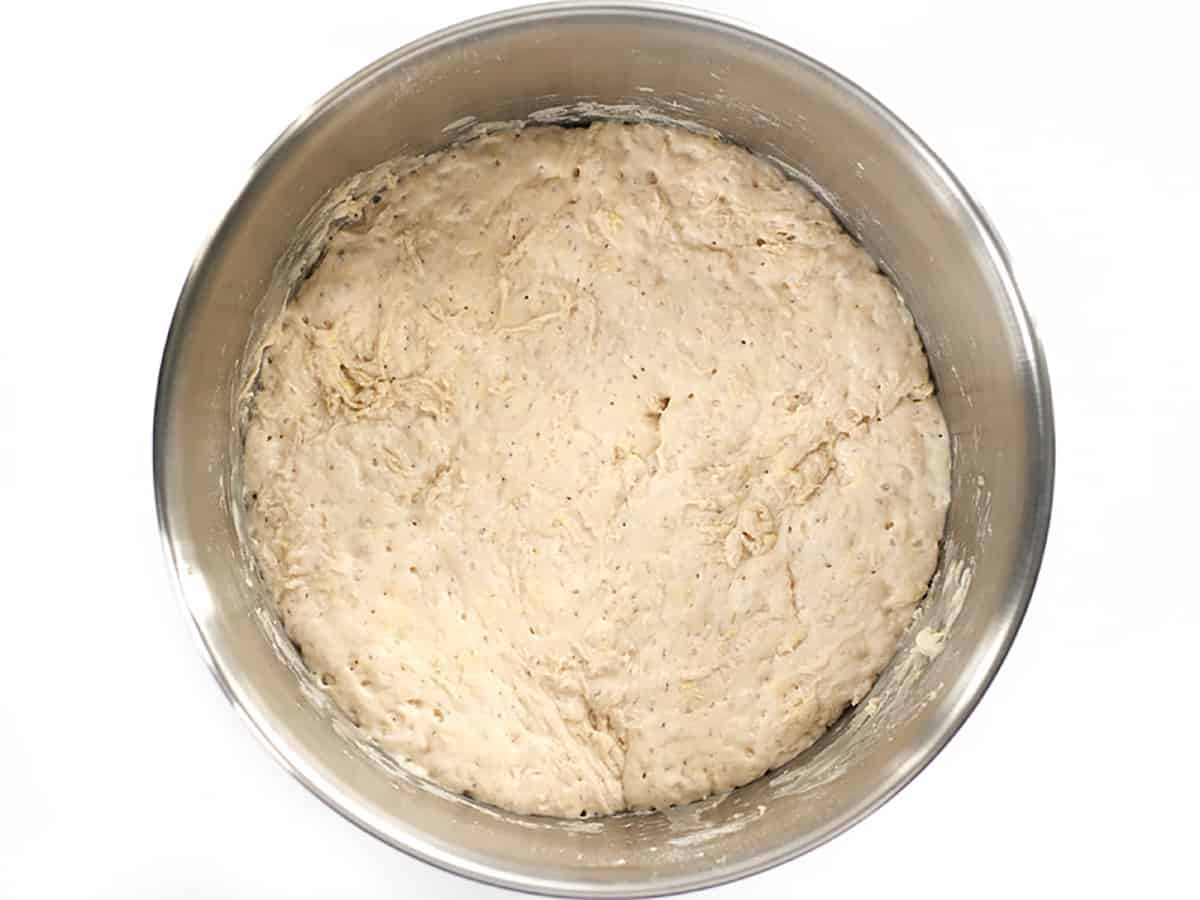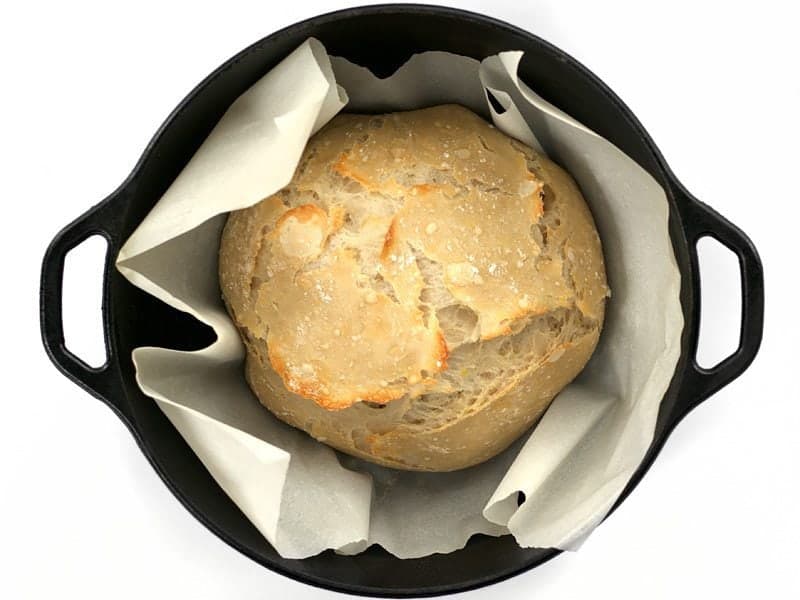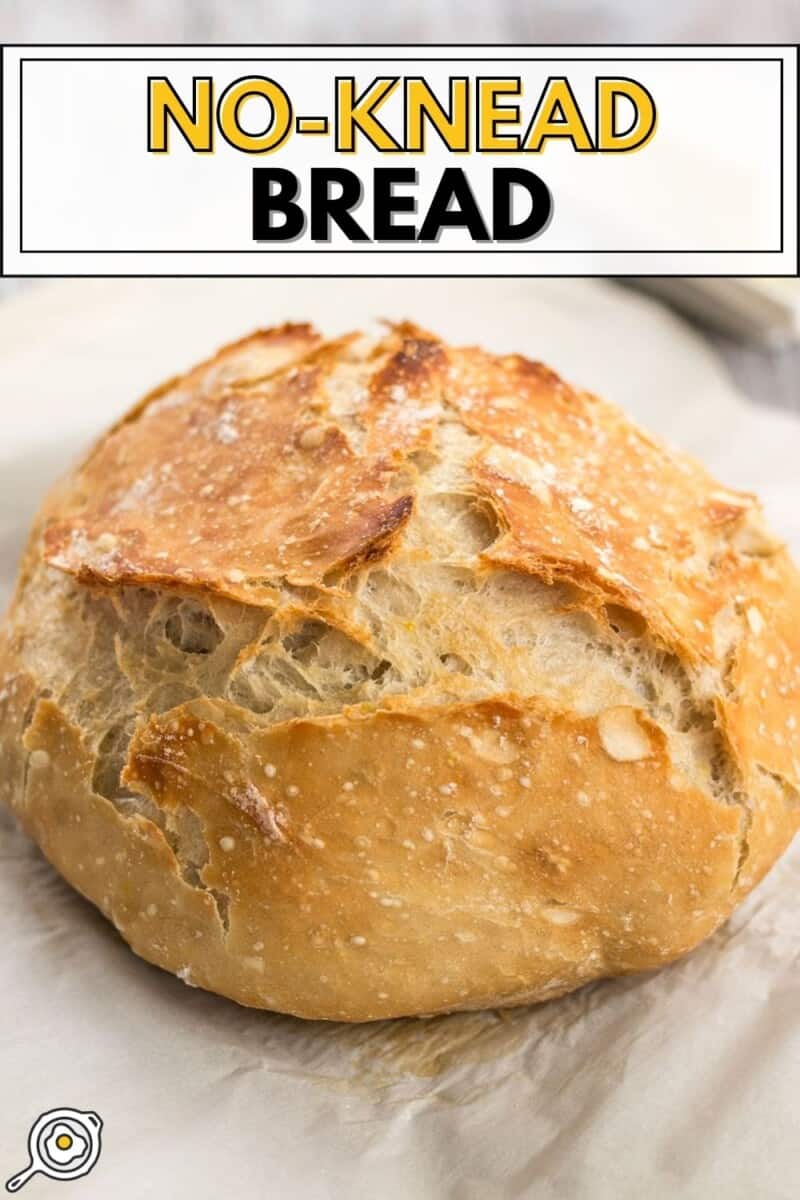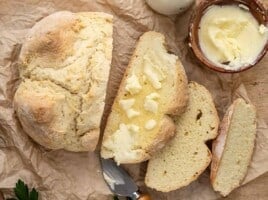I started making no-knead bread in 2010 and it has continued to be my favorite way to make homemade bread because it’s incredibly simple, it doesn’t require a lot of effort, and it makes the most deliciously crusty bakery-style bread ever. To make this no-knead bread recipe you only need four ingredients (including water) and a little bit of time. No fancy equipment or techniques needed!

This post contains some affiliate links, which means that we make a small commission off items you purchase at no additional cost to you.
“I’ve made this twice and it was amazing! Hard to believe something so simple can come together to be something so amazing!”
-Melissa
What Is No Knead Bread?
No-knead bread is an ancient technique for making delicious loaves of bread by utilizing a long fermentation time to develop the gluten the flour instead of hand kneading. Gluten is the protein that gives bread its strength, allowing it to rise into a fluffy loaf, and have that deliciously chewy texture. Kneading bread dough develops gluten quickly, but is quite labor-intensive. If given enough time, yeast can develop the gluten in the dough without the need for manual needing.
Ingredients for No Knead Bread
The best part about this no-knead bread recipe is that it only requires four ingredients, including water, and you still get an incredibly flavorful bread. Here’s all you’ll need to make your own homemade no-knead bread:
- Flour: Our version of no-knead bread was developed using all-purpose flour because that is what we most commonly have on hand. That being said, using bread flour will create even better results. Just keep in mind that bread flour tends to absorb more water than all-purpose flour, so you may need to adjust the ratios slightly.
- Yeast: For this type of bread, we use instant yeast or bread machine yeast, both of which do not need to be activated first by proofing in warm water. You can simply add them to your dry ingredients and go!
- Salt: Without the proper amount of salt, homemade bread will have no flavor, so it’s imperative that you do not skip the salt.
- Water: Water hydrates the flour to create the dough. Because this technique uses a longer ferment time, you can use room-temperature water and you do not have to “wake up” the yeast with warm water. The yeast will have plenty of time to activate as it rests.
What Kind of Yeast to Use
It’s very important to use the correct type of yeast for this recipe. Instant yeast and bread machine yeast are special because they do not require mixing with warm water to “wake up” before adding to a recipe. You can simply stir them into the dry ingredients and they will activate instantly upon hydration, so that is what we use for this super simple no-knead bread technique. Active Dry yeast, on the other hand, needs to be specifically activated in warm water first. If you use active dry yeast in this recipe using the technique below, the bread will likely not rise.
Do I Need to Use a Dutch Oven?
Using a preheated Dutch oven does create the best results because it gives the bread an extra intense boost of heat while retaining all of the moisture and steam. That being said, I have made no-knead bread on a sheet pan with great results! I suggest adding a pan with an inch or so of water on the bottom rack of your oven to create steam if you’re baking your bread on a sheet pan.
If possible, I would suggest investing in a Dutch Oven because they are easily one of the most flexible and useful pieces of cookware. We love our Amazon Basics 6-Quart Enameled Dutch Oven as a very affordable alternative to Le Creuset. Lodge also makes very affordable Enameled Dutch Ovens and plain Cast Iron Dutch Ovens (like the one used in the photos here).
Short Fermentation vs. Long Fermentation
You can make no-knead bread using either a long fermentation (12-18 hours) or a short fermentation (about 2 hours). The difference is that you’ll need more yeast to do the short fermentation and the flavor does not develop quite as deeply. That being said, short fermentation no-knead bread is a great option when you haven’t planned ahead!
Long Fermenation: Follow the instructions below, using ¼ tsp yeast and fermenting the dough for 12-18 hours.
Short Fermentation: Use 2 tsp yeast (or one ¼ oz. packet) and ferment the dough for about 2 hours at room temperature.

No-Knead Bread

Ingredients
- 3 cups all-purpose flour ($0.29)
- 1/4 tsp instant yeast or bread machine yeast* ($0.02)
- 1.5 tsp salt ($0.02)
- 1.5 to 1.75 cup water** ($0.00)
Instructions
- The day before baking, combine the flour, yeast, and salt in a large bowl and stir until they're well combined. Stir in about 1.5 to 1.75 cups room temperature water until a shaggy, sticky ball of dough forms and there is no dry flour left on the bottom of the bowl. The dough should be wet and sticky, but not so wet that it appears glossy. Cover the bowl loosely with plastic and let it sit at room temperature for 12-18 hours.
- The next day, the dough should be fluffy and very bubbly. When you're ready to bake, sprinkle a little flour on top of the fermented dough and scrape it out of the bowl. With well-floured hands, shape the dough into a ball and place it on a piece of parchment paper. Let the dough rise for 30-60 minutes.
- While the dough is rising, preheat the oven to 425ºF, or the highest recommended temperature listed on the packaging for your parchment paper. Place the Dutch oven inside the oven as it preheats, and make sure it sits in the fully heated oven for at least 15 minutes before baking the bread.
- Once the bread has risen and the Dutch oven is fully heated, carefully remove the Dutch oven from the oven (it will be EXTREMELY hot). Lift the parchment with the dough straight into the dutch oven and cover it with the lid.
- Return the Dutch oven to the oven and bake for 30 minutes. Carefully remove the lid and bake for another 15-20 minutes, or until the crust is a deep golden brown. Remove the Dutch oven from the oven, lift the bread out by by using the parchment paper, and allow it to cool before cutting open and serving.
Sheet Pan Instructions
- Ferment and shape the dough as described above, then place it on a parchment-lined sheet pan to rise for an additional 30 minutes.
- Place a baking pan with about an inch of water on the bottom rack of the oven, then preheat to 425ºF while the dough rises.
- Once the loaf has risen for 30 minutes and the oven is fully preheated, carefully score the top of the dough with a sharp knife (use horizontal motions with no downward pressure). Transfer the sheet pan to the oven and bake for 40 minutes, or until the crust is deeply golden brown and the loaf sounds hollow when tapped.
See how we calculate recipe costs here.
Equipment
- Cast Iron Dutch Oven
- Mixing Bowls
- Parchment Paper
- Liquid Measuring Cup
Notes
Nutrition

How to Make No-Knead Bread – Step by Step Photos

Before you begin, make sure you have “instant yeast” or “bread machine yeast” rather than “active dry”. The reason you need this type of yeast specifically is because it does not need to be kick-started by mixing with warm water first. You can add it to a recipe dry and it will still activate. I buy these little jars, which I keep in my fridge, and they last for-ev-er (especially when you’re only using 1/4 tsp at a time)!

The day before you want to actually bake the bread, combine 3 cups all-purpose flour, 1/4 tsp instant or bread machine yeast, and 1/2 Tbsp salt in a large bowl. Stir them together really well.

Stir in about 1.5 to 1.75 cups of room temperature water, or just enough to form a shaggy ball of slightly sticky dough, and no dry flour is left on the bottom of the bowl. The total amount of water needed may vary from time to time depending on the ambient humidity and moisture content of the flour, so go on visuals here. Make sure it comes together in one ball and no dry flour is left on the bottom of the bowl. It’s okay for it to be a bit sticky.

Loosely cover the bowl with plastic and let the dough ferment at room temperature for 12-18 hours. If you need to let it sit longer than that to fit your schedule, just transfer it to the refrigerator. As the dough ferments, it becomes very big, light, fluffy, and bubbly.

Sprinkle a little flour onto the dough (because it will be sticky) and scrape it out of the bowl. It will begin to deflate as you scrape it out.

Using floured hands, shape the dough into a ball, then place it on a large piece of parchment. Let the dough rise for 30-60 minutes. The shorter rise time will produce a slightly more dense bread and the longer rise time will have larger bubbles.

While the dough is rising, begin to preheat the oven and the Dutch oven. Set the oven to 425ºF, or whatever the highest safest temperature is for your brand of parchment (it will usually be listed on the box somewhere). Make sure your Dutch oven is inside the oven as it preheats, and then let it heat for an additional 15 minutes or so once the oven is up to temperature. This makes sure that the Dutch oven is nice and hot.

When the dough is risen and the Dutch oven is fully preheated, carefully remove the Dutch oven from the oven (it will be extremely hot!). Lift the risen dough by the parchment and place it inside the Dutch oven, parchment and all. Place the lid on the Dutch oven and return it to the hot oven.

Let it bake for 30 minutes with the lid on the Dutch Oven, then carefully remove the lid…

Then bake it for an additional 15 minutes or so WITHOUT the lid to allow the crust to brown.

Once the crust achieves a nice deep golden brown color, carefully remove the Dutch Oven from the oven. Lift the no-knead bread out of the Dutch oven by the parchment, and allow it to cool before serving.

And just be prepared for the BEST bread you’ve ever made yourself. ;) The crust on this no-knead bread is seriously amazing.
No Dutch Oven and Short Fermentation Instructions
So, as I mentioned before, you can still bake this bread without a Dutch oven and with a short, 2-hour fermentation time. Here is a photo of my no-knead bread using just 2 hours of fermentation (plus another 1 hr rise time) and baked on a baking sheet.

If you only have about 2-3 hours to ferment the dough, you’ll need to increase the amount of yeast used to 2 tsp (instead of 1/4 tsp).
Let the dough ferment in the bowl for 2 hours, then shape it into a loaf, transfer it to a baking sheet covered with parchment (and sprinkled with cornmeal, if desired) and let rise for about another hour. I like to make slits in the top with a sharp knife after the loaf has risen. Be careful though, if the knife is not sharp enough or you use too much downward pressure, it can deflate the dough.
Brush the surface of the dough with water, then bake it in a preheated oven (again, as hot as the parchment will allow, usually around 425ºF) for 30-40 minutes, or until the crust is nicely browned.







This was my first attempt at making bread, and it did not disappoint. So easy to make and so delicious.
So I made this bread without reading the comments and also experiences the wet blob that others mention. After folding a bit more flour into the dough after the first rise, I placed the blob on parchment into a bowl for the second rise. This encouraged the dough to stay in a round shape. After the second rise, I lifted into the dutch oven as directed. Perfection! Thanks Beth!
I’ve never baked bread before, so there was a bit of a learning curve, but now I’m a bread pro! …For this specific bread, lol.
This recipe has been one of my COVID mainstays. There’s something so cozy and comforting about a house that smells like baking bread! The amount of water I need to get the correct consistence is generally towards the lower end of things – 1.5 cups, if that. And when I transfer the dough from the bowl onto the parchment paper, it does end up as more of a thick puddle or a wet patty than a nice round ball, but it bakes perfectly every time.
I finally got my hands on some yeast! And it’s the kind I love which is in the jar. I guess I’ll list the steps I took since the outcome wasn’t ideal…I let the bread proof for the full 18 hours in a plastic mixing bowl. It grew quite a bit and like otherwise it was quite sticky and stuck to my parchment paper some. So I put it back into my plastic bowl and layered on the flour a few times after “kneading” it some. That helped. From there when forming it into a ball-ish, I just put it into the oven…I didn’t allow it to proof an extra our on the baking sheet. I’m wondering if that’s why it caused the bread not to grow in height much. Also, my parchment paper said up to 400° so I did the first 30 mins and then the last 10 mins I increased it to the 425° since the color of my bread wasn’t looking like that in your pictures. My bread was also pretty hard when first coming out of the oven but after it cooled it was softer but still had a nice crunch. I think next time I’ll allow my bread to rise that extra hour once on the baking sheet and stick to the 425° (I think I saw in a previous comment, Beth, that you said that was okay?). If that doesn’t work then I may have to get myself a Dutch oven finally. :-)
Yep, you definitely need to let it do that second rise. :) It will rise up some once it hits that hot oven, but it needs a little time before that as well for the yeast to produce some more gas. It’s like a one-two punch. While I can’t legally tell you that it’s safe to put the parchment in the 425ºF oven, all I can tell you is that I’ve done it successfully many times in the past. Bake at your own risk or search to see if you can find another brand that specifies that it’s safe at 425. :)
I ended up using the instant yeast, after all. However, after I let it sit 18 hours or so, the dough ended up being a slimy patty when I set it out to rise. I feel like I did something wrong (too much water?). I’m going to see if it rises after an hour, but it hardly held together as I tried to form a ball of it. What did I do wrong?
Oh my god, same. It always looked a little wet so I added more flour and still the result is more of a disk than a ball. I’m midway thru the second rise and can’t wait to see how this bread turns out. It may be a mess! 😂
I have plenty of flour and yeast so I won’t feel bad if this comes out weird cause I can always try again.
Mine never forms a ball either – more like a thick puddle. But it always seems to come out of the Dutch oven as a well-formed loaf, so I’m not too worried about it.
I’m interested to hear how yours came out – was the end result a loaf, or more like a pancake?
If I have the “active dry” yeast, will this still work if I just kick start it and then add it as your recipe instructs?
The first time I made no-knead bread, I used active yeast, activated it first in a little bit of warm water, and just used a little less room temperature water. let it rise/sit for 15 hours, or around that. It was great!
Thank you! I will try it.
So I got instant yeast after all. However, I got a slimy patty after letting it sit out at room temperature for the max time. It is sitting there trying to rise, but it looks like a raw pancake and was very sticky and slimy in my well-floured hands. How did I mess this up?
I’m sorry to hear that! It’s hard to say what happened without being there and seeing what happened.
I will try again. I’m wondering… when measuring the flour, should I pack it tight?
I have made this several times and love it. This time I noticed a sort of vinegary smell while it was baking so I think that means it is now sour dough? The dough sat covered on the counter for about 16 hours. It was very well-risen after a couple hours but didn’t realize that there was a short-fermentation alternative until I went to the comments section today. I definitely prefer a yeast smell and taste to sour, so going forward will use the short fermentation method and then repost.
So easy and hits the spot every time.
Question – Can I break this into two small loaves and bake both in the dutch oven? I want to make smaller loaves in one batch so I can gift mini-loaves.
I love this recipe! I haven’t tried the shorter fermentation method with the extra yeast yet, but I want to give it a go. My question– can I use the shorter fermentation recipe but still bake it in the Dutch oven like the original recipe, or does it need to be baked on a sheet? I would vastly prefer to use the Dutch oven. I live in the desert and it’s sooooo incredibly dry here. I have found that a wetter dough and a Dutch oven are about the only way I can make any bread that isn’t inedible!
You definitely can still use the dutch oven. Enjoy!
What am I doing wrong? I can’t form my dough into a ball. I get as close as I can and put it on the parchment paper but it just forms a puddle of dough. The first time I made it I had the same problem so assumed I had added too much water. The first time I used 1 3/4 cups and this time 1 1/2 but have gotten the same results.
Hi Carol, because this dough is quite a bit more wet and loose than traditional bread dough, it doesn’t shape quite the same. Just form it into a circle as best you can. It won’t be fully round like a globe, but more flat. As it rises it will rise more out than up, but once it hits that hot air in the preheated Dutch oven it will rise up instead of out.
I love how easy this recipe. Is. I am wondering how to get a loaf of bread that doesn’t crumble s much. I used the short-rise/more yeast version of the recipe.
OMG!!! This bread is just delicious. Easy, simple and delicious. Thank you for this recipe.
This is an awesome recipe and I’ve made it dozens of times over the years. I feel like I’ve finally perfected it. First, I use just 1.5 cups water for the 3 cups flour and the consistency is always right now. Secondly, I rise it for just about 12-13 hours on the countertop, I don’t go for the full 18-24 anymore. I think my failures with this recipe (and previously thinking it was inconsistent) stem from it deflating during the rise when I left it too long. Cool the bread almost completely – should barely be warm to the touch – then slice the whole loaf. It’s much easier to slice when it’s fresh but you have to let it cool and the steam distribute for a perfectly soft loaf.
All that said, this is the easiest and most perfect bread recipe that I’ve been making multiple times a week for over a year. I’ve also introduced many others to no knead bread this way! Although I know the concept isn’t a Budget Bytes original this is a wonderful starting point. Going to pop my loaf in the oven now!
We’ve been using this for a couple weeks now. Turns out fantastic every time. Great recipe and the guide was a breeze to follow. Thanks!
Easy and delicious recipe! Has anyone tried adding any flavoring or extras such as garlic, cheese, nuts? Just wondering if that works and at what point in the recipe would you add it.
I add about 3 oz shredded Asiago cheese. 2 oz after I scrape the dough out of the bowl, that gets folded in as I shape the dough. Then I add 1 oz on top once it’s on the parchment paper. Beth also posted a recipe for sun dried tomato no knead bread where she mixes things in before letting it rise, so that should work too!